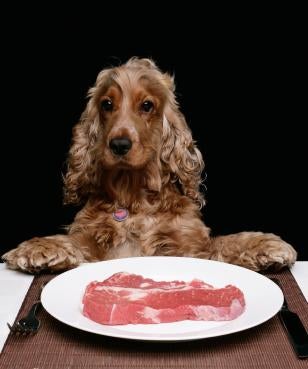Hot Dog! It's Home Cookin'! Want More Wags? Then Ditch The Bags
Homemade Dog Food Recipes...
What would you prefer? A TV dinner, or a homemade stew made by Mom herself? Most of us have eaten both, and have a preference. I can't speak for your mother's cooking ability, but chances are, she can do a bit better than a frozen brick of kinda-food. This example may make it easier to empathize with your dog when you fill his bowl with nuggets of processed corn meal and he glances up your way that saying, "You've got to be kidding me."
Or, maybe your best buddy is more than willing to scarf down anything that hits the bowl. In that case, you might want to ask yourself, "Is conventional dog food the best thing for him?" Your dinner choices might be a no-brainer, but choosing the best option for your pet isn't always that easy. He's relying on you to make the healthiest, and most enjoyable, choices for him.
Share your favorite homemade dog food recipe with our community of dog lovers - submit recipe here.

[google_ad:DOTR_CMS_468x60_InArticle1]
When you make food at home for your dog, you are ensured that your dog is eating food that meets your standards, and is free of preservatives, fillers, and chemicals that are often found in commercial dog foods.
Join me, and we'll discuss the questions that both you and your dog have been asking about homemade dog food. We'll explore the different avenues available to gain and maintain a healthy coat and skin, lean muscle, strong bones and teeth, hearty organs and immune systems, high energy, efficient digestion, and an increased life expectancy. In other words, all the things we want for our much loved dogs.
Are There Different Types of Homemade Dog Food?
You betcha. Much like human food, homemade dog food can be categorized in order to narrow the search for your best friend's most beneficial diet. But, lines can be blurred, and concepts can overlap. For instance, you may choose to feed a raw dog food diet while avoiding all of the foods that experts have deemed potentially harmful. Or you may want to employ holistic health concepts while using all organic ingredients. That's what homemade dog food is all about, after all - customizing your dog's diet in a way that fulfills both of you.In the most sensible manner, we'll start where the meat does: Raw.
Raw Dog Food, or BARF (Biologically Appropriate Raw Food - or - Bones and Raw Food):
Your dog is a wild animal that has been domesticated (some more than others). And, as with humans, any species' best diet is its native one. And a dog's native diet? MEAT.Additionally, many would attest that raw meat is optimal. Unlike humans, dogs are not generally susceptible to things like salmonella and e-coli. You and I might regularly eat raw meat if our systems could handle it - but we need to cook our meat to kill the bacteria that have the potential to devastate our digestive systems.

When meat is cooked, proteins, vitamins, and minerals break down and lose their benefit. Raw meat is also high in moisture - it provides a significant amount of your dog's daily water requirement (and that's great for proper kidney function). The great majority of your dog's diet should consist of meat protein - which is the one fool-proof ingredient that we know all dogs can digest and thrive on.
Commercial dog foods contain soy, corn, and wheat - all common allergens for dogs. Raw dog food advocates maintain that all grains should be eliminated from our dogs' diets. They also cite that grains have been blamed as culprits for pancreatic stress and tooth calculus, that our dogs were not designed to process these items, and that asking them to thrive on grains is like asking a human to thrive on a red meat diet - most experts would advise against it.
Let's start by discussing what a raw-food dog's diet should consist of. All meat should, obviously, be uncooked, and may include: Eggs (with shell), beef, buffalo, venison, elk, chicken, turkey, emu, ostrich, rabbit, and fish. Small animals, like rabbits and fish, may be fed whole - dogs love it this way.
At least 60-80% of your dog's raw food diet should consist of raw meat. Further broken down, that meat allowance should be roughly 20% organs, 20% skin and fat, and 35% muscle meat.
Bones included in a fresh kill are okay, and hold nutrition essential to your dog's well being. Beware, though - never feed old bones that have been inside a dead animal for any length of time or that have been preserved in any way. The best bone is a just-dead one. A fresh kill rabbit or a whole, fresh chicken provide whole meat and bone nutrition. And, yes, chicken bones are safe to feed your dog, provided that they remain fresh and uncooked (ask your Vet if you are still unsure). Bones become brittle and prone to splintering after they're cooked. When fresh, they are more easily chewed and digested.
Vegetables may be combined with meat, to account for 20-40% of your dog's diet. Appropriate ones include: Broccoli, squash, Romaine lettuce, carrots, cabbage, celery, and asparagus. Take note to any bloating or gas problems that your dog may experience. If he's looking distended and feels sluggish, start by eliminating the broccoli (that's usually the culprit), and then move on to the others until you find the gas-maker.
Where to get the raw meat? That's easy - visit your local butcher. Ever wonder what happens to the parts that we don't eat? Likely, they're tossed into the dumpster. Ask that butcher for left-overs, such as animal carcasses, necks, backs, feet, and tails. But remember - all meat should be fit for human consumption. Our dogs' systems can handle more than ours, but don't forget that you'll be handling the meat. After preparing meals for your dog, cleaning up with pure white vinegar will eliminate any bacteria from countertops and feeding bowls.
And yes, we know that there is garlic included in some of these recipes. Please note that when portionally correct amounts are included in your dog's food, it can be beneficial to its health. It's only when too much garlic, in relation to your dog's weight, is dangerous to your dog's health. You can read more about it here.
Intrigued? Ready to reintroduce your dog to his roots? Here's a homemade dog food recipe that he's bound to relish:
Raw Meat Mix - The Unstew
$7.00, 10 minutesRaise your paw if you like it raw!

1 lb. raw ground meat
2 cups ground or pureed vegetables
2-4 oz. raw organ meat (liver, gizzards, etc.)
half cup apple cider vinegar
2-3 cloves garlic
1 T ground kelp
half cup plain yogurt
3 eggs with shells
palmful of parsley
Mix all ingredients (chop, puree, or leave in large chunks, depending on your dog's preference) and store in the refrigerator or freezer. This mixture should account for 20-40% of your dog's daily diet.
The remaining 60-80% of your raw-food-eating dog's daily requirement should consist of raw meat and bones (backs, necks, carcasses). These items should range from $0.00 - $2.00 per pound, depending on how friendly you are with your butcher.
In raw conclusion...
Of course, percentages of meat to vegetables is approximate. But most raw food experts agree - the most important part of a raw dog food diet is the meat. Our furry friends are carnivores, and eat little or no vegetables in the wild.
Benefits of a raw dog food diet include fewer, and more compact stools; muscle development in the jaw, neck, and shoulders (resulting from the chewing required by the meat and bone diet); better digestion due to slower, labored chewing; and an extended lifespan - thanks to an adherence to a natural, unprocessed, diet.
Have an aversion to feeding raw meat? Is your dog a scarfer, not skilled at chewing bones? Then debone it! Cook it! Read on for recipes that cater to the more evolved canine.
Organic, Homemade Dog Food - Good Food in the Nude
You'd have to be living under a rock if you've missed all of the buzz about organic foods. Even your dog's heard about it. A whole pack of folks believe that pesticides, herbicides, human waste, sewage sludge, radiation, genetic modification, and artificial additives have no place in or on our produce. But what about meat? Did you know that your meat - and the meat that you prepare for your dog - can be organic, too?Organic meat is harvested from animals that have been raised without artificial growth hormones or antibiotics, and have not been fed animal by-products. Organic foods provide no more nutritional value than conventional ones, but their attraction is strictly about what's NOT in them. You'll be paying more for less (about twice as much) - but, it's less of what you DON'T want. Most grocers carry organic meat, and if they don't, ask for it.
Almost any homemade dog food recipe can be converted to organic - by simply replacing conventional ingredients with organically-produced ones. Here's one that will fly out of the bowl:
Organic Wings 'N' Things
$7.00, 5 minuteshalf cup organic cottage cheese
half cup organic grated carrots
4-5 organic skin-on raw chicken wings (or cooked organic chicken, with bones removed)
Pile up your dog's bowl (using our weight calculator) with these yummy ingredients and watch 'em fly.

Homemade Holistic Dog Food - Feeding the Whole Dog
Holistic feeding methods and medicine stand upon the idea that feeding the mind and body will serve to restore and maintain health and vitality. Principles include ideals such as balance and variety. Holistic diets may be fed raw or cooked - your choice.Meal rotation and variety is essential to holistic health principles, just as variety is essential to your own good daily diet. Dogs are naturally less carnivorous than cats. Their teeth testify to this - if you open the trap, you'll notice canines for ripping and grinders for other items that they naturally ingest while foraging in the wild.
Holistic dog food notions dictate that grains are okay for dogs - based on the premise that when dogs eat wild animals, they also ingest the stomach contents of those animals, including grains and greens. Many holistic dog food recipes hover right around 2 parts protein, 1 part carbohydrates, and 1 part vegetables. Using these guidelines, you can whip up any number of recipes. Here's a yummy example:
Buffaloaf
$10.00, 1 hour3 cups ground buffalo (lean)
2 eggs
1 and a half cups old fashioned oats
three quarter's of a cup grated mixed vegetables, including zucchini, broccoli, carrots, and sweet potato
half cup cottage cheese
Preheat oven to 350 degrees F. Hand-mix all ingredients and press into a loaf pan. Bake for 40 minutes. May be refrigerated, or frozen in slices for easy serving.
Substitute ground turkey, chicken, or beef, if desired. Mixing meats is not recommended.
Do Supplements Have A Place In Your Dog's Diet?
Though opinions differ greatly, I believe that a healthy dog's nutritional requirements can be fulfilled with little more than food and sunshine. Calcium and Magnesium levels are generally the only two deficiency concerns when feeding a homemade dog food recipe diet. You may supplement calcium with unflavored yogurt, white cheese, pulverized egg shells, and sardines. Vitamin D (to release the calcium) can be obtained from cod liver oil or time spent outside, in the sunshine. Magnesium is found in kelp and spinach, which are both acceptable, but only when steamed first.
The Indisputably Healthy Dog
No matter the feeding principle that you choose for your dog, some ideals encounter little argument among professionals:Dogs need protein - vegetarian diets are widely disputed and do not offer complete nutrition for animals that are primarily carnivorous.
Commercial dog foods that contain a large percentage of grains offer little nutrition. Just look at a commercially-fed dog's poop. It's almost as big as when it went in!
Some commercial dog foods contain fillers...and more sinister ingredients, such as cancerous tissue, by-products of sick animals, shelter kills, and preservatives. Toxins aren't strangers either, as many tragically learned not so long ago (dog food recalls of 07 & 08).
Foods that are bad for you are probably bad for your dog. Fried foods and sugar-laden treats sabotage other valiant efforts and provide little or no nutritional value. Not to mention the belly aches!
Certain foods should be avoided completely, including:
Grapes and raisins, Onions, Mushrooms, Avocado, Hulled foods (corn, beans, peas), Tomatoes, Fruit, fruit pits and seeds, Macadamia nuts, Walnuts, Chocolate, Cooked bones, Coffee and tea, Yeast, Nutmeg, Salt, White foods (white bread, white rice), Foods included in the nightshade category may cause problems for some dogs (eggplant, peppers, tomatoes, white potatoes, iceberg lettuce, and raw spinach), and for some dogs, dairy can be pretty scary.
Kicking Portion Distortion
Not sure about your dog's appropriate feeding portion? 2-3% of total body weight is appropriate for most dogs. Very young dogs may need a bit more, while older or inactive dogs require less.To calculate, multiply his weight, in pounds, by 16 to get his total body weight in ounces. Feed him 2-3% of that weight, daily. For example, if your dog weighs 50 pounds...
50 lb. x 16 oz. = 800 oz. (total body weight in ounces)
800 oz. x .02 = 16 oz. (total daily minimum food weight)
OR
800 oz. x .03 = 24 oz. (total daily maximum food weight)
You may choose to divide your dog's daily food into two feedings, or you may want to stick with one daily meal. Whatever your dog is accustomed to is fine.
Or, you may choose to count calories...
Dogs that weigh-in at less than 20 pounds generally require 40 calories per pound per day. For instance, your 12 pound Yorkie will require approximately 480 calories per day (12 lb. x 40 cal. = 480 cal. per day).
Dogs that tip the scales at over 100 pounds usually need about 15 calories per pound of body weight, per day. For example, a 120 pound Great Dane will need roughly 1800 calories per day (120 lb. x 15 cal. = 1800 cal. per day).
On average, dogs require about 25 calories per pound of body weight, per day. If in any doubt, less is always more. Moderate canine body weight has proven to extend the lives of our best friends. And who doesn't want even just one more day?
More Main Dish Recipes - Good Food with Attitude
Now that you have learned about the basics of home cooking for your dog, you can stir up these and many other recipes of your own creation. Here are just a few to spark your imagination. Remember, all foods should be served at room temperature, and left-overs may be stored in the refrigerator, tightly covered, for up to 4 days. Or, individual servings may be frozen for future defrosting and feeding.
Canine Casserole Recipe
$3.50, 15 minutes1 cup cooked chicken or turkey
half cup steamed vegetables (carrots, broccoli, squash, spinach, sweet potato)
half cup prepared brown rice
4 Tbsp. no-sodium broth
Combine all ingredients.
Nice Rrrrice
$3.50, 40 minutes2/3 cup meat of choice, cubed
three quarters of a cup carrot and sweet potato, cubed
three quarters cup instant brown rice
1 cup water
quarter tsp. garlic powder
Add all ingredients, except rice, to large pot and boil. When vegetables are tender, add rice and cook until done. Add more water as needed during cooking.
Pupper Fish
$4.50, 30 minutes1 can salmon, deboned
1 beaten egg
3 Tbsp. cornmeal
1 potato
1 carrot
1 celery stalk
Cottage cheese or plain yogurt
Combine salmon, egg, and cornmeal. Form into patties and press into more cornmeal. Sautee in a canola sprayed pan until cooked through. Chop and steam the vegetables. Cut salmon patties into small bites and combine with the vegetables. If the mixture seems too dry, add a bit of cottage cheese or yoghurt.
Wrapping it up...Should You Cook For Your Dog?
Understandably, you may feel overwhelmed at the idea of feeding your dog from your own kitchen. Maybe you have little time to cook even for your own human family. Consider employing any of the following time-saving ideas to make your dog's increased well being and longevity possible:
- Instead of chopping fresh vegetables, keep bags of frozen ones on hand.
- Instead of pureeing vegetables, use prepared baby food.
- Prepare dishes in advance and freeze in individual serving sizes.
- Eat what your dog eats - prepare dishes that everyone (and every dog) can enjoy.
- Strike an agreement with your butcher. Talk to him about what you're looking for, and schedule a particular day of the week when you can stop in and pick up what he's reserved just for you.
- Use your slow cooker! Pop approved ingredients into the crock pot before you go to work in the morning.
- Involve other members of the household. Everyone can benefit from feeding Fido.
- Use the satisfied expression on your dog's face to fuel your finding of a few extra minutes every day...to give him a few extra years.
Well, here's wishing you good luck, good eating, and many years to come with your kitchen's newest customer. He may not be a big tipper, but you'll be paid with as many licks and as much love as you can digest!
Do You Have A Dog Food Recipe That You'd Like To Share? Contact Us!
Check Out Some Other Tasty Dog Food Recipes
Click below to see some awesome recipes from other visitors to this page...
Dalmatian Turkeyloaf with Vegetables
![]()
![]()
![]()
![]()
![]()
My dog loves this recipe - he's a fussy eater normally but when this hits his bowl, it doesn't last long!
1 1/2 pounds lean ground turkey
3 stalks celery,...
Chicken Cutlet with Proplan Kibble
Not rated yet
First in a non stick pan i put a chicken cutlet.
Cook it until its tender on inside and slightly brown on outside...put some frozen peas carrots in ...
Doggy Stir fry
Not rated yet
Ingredients:
1 pound lean ground beef
5/4 carrots
about 2 stalks broccoli
whole wheat pasta
In a pan cook meat carrots and broccoli together ...
Peanut Butter Dog Biscuits
Not rated yet
My little yorkie goes crazy for these biscuits.
Source: http://www.dog-food-recipes.com
Ingredients:
1 cp flour
1/2 cp milk
1/4 cp parmesan ...
Some other pages you may be interested in:
Learn how to train your puppy the positive, non-violent, but super effective way - puppy training step by step.
Teach your dog some cool dog tricks.
Please consult the services of a Professional Dog Trainer, Behaviorist or Veterinarian before implementing any of the advice contained on this site.








 Your Privacy Choices
Your Privacy Choices